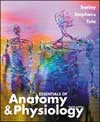 |
1 |  | 
The basic living unit of all organisms is the |
|  | A) | organelle. |
|  | B) | cell. |
|  | C) | tissue. |
|  | D) | organ. |
|  | E) | organ system. |
 |
 |
2 |  | 
Given these levels of organization: 1. cell, 2. chemical, 3. organelle, 4. organ, 5. tissue. Choose the arrangement that lists the levels of organization in the correct order from smallest to largest. |
|  | A) | 1,2,3,4,5 |
|  | B) | 2,3,1,5,4 |
|  | C) | 3,2,1,4,5 |
|  | D) | 4,1,3,2,5 |
|  | E) | 5,3,1,4,2 |
 |
 |
3 |  | 
Homeostasis is an example of which of the following characteristics of life? |
|  | A) | organization |
|  | B) | metabolism |
|  | C) | responsiveness |
|  | D) | growth |
|  | E) | differentiation |
 |
 |
4 |  | 
Homeostatic mechanisms |
|  | A) | keep variables exactly at the set point. |
|  | B) | help to keep a relatively constant internal environment in the body. |
|  | C) | act to keep values out of the normal range. |
|  | D) | usually operate by positive feedback. |
|  | E) | produce most disease conditions. |
 |
 |
5 |  | 
Negative-feedback mechanisms |
|  | A) | are not homeostatic. |
|  | B) | are rare in healthy individuals. |
|  | C) | respond by making deviations from normal even larger. |
|  | D) | are counteracted by most medical therapy. |
|  | E) | may have a receptor, a control center, and an effector. |
 |
 |
6 |  | 
Which of these conditions indicate positive feedback has occurred? |
|  | A) | Blood pressure decreases greatly; blood flow to the heart is inadequate, and blood pressure decreases. |
|  | B) | Hot temperatures increase your body temperature above normal; you sweat. |
|  | C) | Cold temperatures decrease your body temperature below normal; you shiver. |
|  | D) | Blood pressure decreases; as a result, your heart rate increases. |
 |
 |
7 |  | 
A term that means "toward the midline" is: |
|  | A) | distal |
|  | B) | lateral |
|  | C) | medial |
|  | D) | proximal |
|  | E) | superior |
 |
 |
8 |  | 
The wrist is ______ to the hand. |
|  | A) | distal |
|  | B) | inferior |
|  | C) | lateral |
|  | D) | medial |
|  | E) | proximal |
 |
 |
9 |  | 
Coronal (frontal) planes divide the body into ______ portions. |
|  | A) | right and left |
|  | B) | anterior and posterior |
|  | C) | superior and inferior |
|  | D) | dorsal and ventral |
|  | E) | both b and d |
 |
 |
10 |  | 
Which of these planes can divide the body into equal halves? |
|  | A) | frontal (coronal) |
|  | B) | sagittal |
|  | C) | transverse |
 |
 |
11 |  | 
Which of these statements concerning body regions is correct? |
|  | A) | The trunk region between the thorax and pelvis is the abdomen. |
|  | B) | The leg extends from the hip to the ankle. |
|  | C) | The forearm extends from the shoulder to the wrist. |
|  | D) | The trunk can be divided into the thorax and pelvis. |
|  | E) | The thorax is often subdivided superficially into four quadrants. |
 |
 |
12 |  | 
The thoracic cavity is divided into two parts by the |
|  | A) | mediastinum. |
|  | B) | pleural cavity. |
|  | C) | diaphragm. |
|  | D) | peritoneal membranes. |
|  | E) | pelvic cavity. |
 |
 |
13 |  | 
Serous membranes |
|  | A) | line body cavities that open to the outside. |
|  | B) | produce a lubricating film of fluid. |
|  | C) | are found only on the walls of the thoracic cavity. |
|  | D) | separate the abdominal cavity from the pelvic cavity. |
|  | E) | completely cover retroperitoneal organs. |
 |
 |
14 |  | 
The serous membrane on the surface of the lungs is called |
|  | A) | parietal pericardium. |
|  | B) | visceral pericardium. |
|  | C) | parietal pleura. |
|  | D) | visceral pleura. |
|  | E) | parietal peritoneum. |
 |
 |
15 |  | 
You are standing on your head. Your head is to your neck. |
|  | A) | superior |
|  | B) | inferior |
|  | C) | superficial |
|  | D) | medial |
|  | E) | proximal |
 |



 2002 McGraw-Hill Higher Education
2002 McGraw-Hill Higher Education